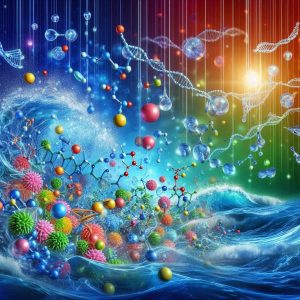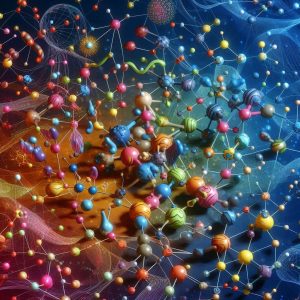Understanding the Chemistry of Life
The chemistry of life refers to the complex chemical processes and substances that are fundamental to living organisms. At its core, biochemistry is the study of these processes, providing insights into how life functions at a molecular level. This article delves into the essential components and reactions underpinning life’s chemistry.
1. Biomolecules
Living organisms are composed of various biomolecules that perform critical functions. The four major types of biomolecules are:
- Carbohydrates: Serve as energy sources and structural components. Examples include glucose and cellulose.
- Proteins: Made up of amino acids, proteins are involved in catalyzing biochemical reactions, signaling, and providing structural support.
- Lipids: Include fats, oils, and phospholipids, playing roles in energy storage, membrane structure, and signaling.
- Nucleic Acids: DNA and RNA store and transmit genetic information.
2. Metabolic Pathways
Metabolism encompasses all the chemical reactions that occur within a living organism to maintain life. These reactions are organized into metabolic pathways, which can be broadly categorized into two types:
- Anabolism: The synthesis of complex molecules from simpler ones, typically requiring energy. Examples include protein synthesis and DNA replication.
- Catabolism: The breakdown of complex molecules into simpler ones, releasing energy. Examples include glycolysis and the citric acid cycle.
3. Enzymes
Enzymes are biological catalysts that speed up chemical reactions in the body. They are essential for sustaining life, as they regulate the rate of virtually all biochemical reactions. Enzymes are highly specific, meaning each enzyme typically catalyzes only one type of reaction or reacts with a specific substrate.
4. Cellular Respiration
Cellular respiration is a metabolic process that converts biochemical energy from nutrients into adenosine triphosphate (ATP), releasing waste products. The process can be divided into three main stages:
- Glycolysis: The breakdown of glucose into pyruvate, yielding ATP and NADH.
- Citric Acid Cycle (Krebs Cycle): Oxidizes acetyl-CoA to CO2, generating NADH, FADH2, and ATP.
- Oxidative Phosphorylation: Uses electrons from NADH and FADH2 to create a proton gradient that drives ATP synthesis.
5. Photosynthesis
Photosynthesis is the process by which plants, algae, and some bacteria convert light energy into chemical energy, storing it in the bonds of glucose. The process can be summarized in two main stages:
- Light Reactions: Convert solar energy into chemical energy (ATP and NADPH).
- Calvin Cycle: Uses ATP and NADPH to convert CO2 into glucose.
Key Components of the Chemistry of Life
| Component | Function | Examples |
|---|---|---|
| Carbohydrates | Energy source, structural components | Glucose, Cellulose |
| Proteins | Catalysis, signaling, structural support | Enzymes, Antibodies |
| Lipids | Energy storage, membrane structure | Triglycerides, Phospholipids |
| Nucleic Acids | Genetic information storage and transfer | DNA, RNA |
6. Importance of Water
Water is fundamental to the chemistry of life. It serves as a solvent, medium for chemical reactions, and is involved in maintaining cell structure and function. Water’s unique properties, such as its polarity and ability to form hydrogen bonds, make it indispensable for life processes.
Table: Key Roles of Water in Biological Systems
7. pH and Homeostasis
The pH level of biological fluids is tightly regulated to maintain homeostasis. Enzymatic activities and biochemical reactions are highly sensitive to pH changes, making pH regulation essential for the proper functioning of cells and organs.
8. Bioenergetics
Bioenergetics is the study of energy flow through living systems. Understanding how cells transform energy through processes like cellular respiration and photosynthesis is crucial for comprehending how organisms sustain life.
Details: The Importance of Water in the Chemistry of Life
Water is often referred to as the “universal solvent” and is crucial for life on Earth. Its unique chemical and physical properties make it indispensable in biological processes. Below, we explore the significant roles of water in the chemistry of life.

Chemical Properties of Water
Water (H2O) is a polar molecule with a partial positive charge on the hydrogen atoms and a partial negative charge on the oxygen atom. This polarity allows water to form hydrogen bonds, which are essential for its solvent capabilities and various biological functions.
Water as a Solvent
Water’s ability to dissolve a wide range of substances makes it an excellent solvent. This property is critical for the biochemical reactions that sustain life:
- Transport of Nutrients and Waste: Water dissolves nutrients, allowing them to be transported through blood and cellular fluids. It also helps in the removal of waste products from the body.
- Metabolic Reactions: Many biochemical reactions occur in aqueous environments. Water’s solvent properties facilitate the interactions between enzymes and substrates, essential for metabolism.
Thermoregulation and Homeostasis
Water has a high specific heat capacity, which means it can absorb and retain significant amounts of heat. This property helps organisms maintain stable internal temperatures, critical for homeostasis.
- Sweating: Evaporation of sweat from the skin surface dissipates heat, cooling the body.
- Circulation: Blood, which is mostly water, distributes heat throughout the body, ensuring temperature regulation.
Cell Structure and Function
Water is vital for maintaining the structure and function of cells:
- Cell Membranes: The hydrophobic and hydrophilic interactions in cell membranes depend on water, which helps form the lipid bilayer, essential for cellular integrity.
- Cellular Processes: Cytoplasm, the fluid inside cells, is primarily water, enabling the movement of molecules and organelles for proper cellular function.
Chemical Reactions
Water is directly involved in numerous chemical reactions within living organisms:
- Hydrolysis: Water molecules break down complex molecules into simpler ones, a process crucial for digestion and metabolism.
- Dehydration Synthesis: Water is removed to form bonds between molecules, essential for the synthesis of proteins, nucleic acids, and other macromolecules.
Table: Key Roles of Water in Biological Systems
| Role | Description | Importance |
|---|---|---|
| Solvent | Dissolves nutrients and waste products | Enables nutrient transport and metabolic reactions |
| Thermoregulation | Absorbs and retains heat | Maintains stable internal temperatures |
| Cell Structure | Supports cell membranes and cytoplasm | Ensures cellular integrity and function |
| Chemical Reactions | Participates in hydrolysis and dehydration synthesis | Crucial for digestion, metabolism, and macromolecule synthesis |
The Role of pH and Homeostasis in the Chemistry of Life
pH, a measure of the hydrogen ion concentration, plays a critical role in maintaining homeostasis in living organisms. Homeostasis refers to the dynamic equilibrium that organisms maintain to ensure stable internal conditions despite external changes. This article explores the importance of pH and homeostasis in the chemistry of life.

Understanding pH
pH is a logarithmic scale ranging from 0 to 14, with 7 being neutral. Values below 7 indicate acidity, while values above 7 indicate alkalinity. The pH of different body fluids must be tightly regulated to support various biochemical processes.
The Importance of pH in Biological Systems
pH influences numerous biological functions and processes, including:
- Enzyme Activity: Enzymes, which catalyze biochemical reactions, have optimal pH ranges. Deviations from this range can denature enzymes or reduce their activity.
- Metabolism: Many metabolic pathways are pH-sensitive, affecting the efficiency of energy production and the synthesis of biomolecules.
- Cellular Function: The pH of intracellular and extracellular fluids influences cellular processes, including signal transduction and nutrient transport.
Homeostasis and pH Regulation
Homeostasis involves various mechanisms to maintain stable pH levels in body fluids, ensuring optimal conditions for biological functions:
- Buffer Systems: Buffer systems, such as the bicarbonate buffer system in blood, resist changes in pH by neutralizing excess acids or bases.
- Respiratory Regulation: The respiratory system helps regulate pH by controlling the levels of carbon dioxide (CO2), which affects acidity in the blood.
- Renal Regulation: The kidneys maintain pH balance by excreting hydrogen ions (H+) and reabsorbing bicarbonate (HCO3–).
Table: Key Mechanisms of pH Regulation in the Body
| Mechanism | Description | Importance |
|---|---|---|
| Buffer Systems | Neutralize excess acids or bases to maintain pH balance | Immediate response to pH fluctuations |
| Respiratory Regulation | Controls CO2 levels through breathing | Modulates blood acidity via CO2 elimination |
| Renal Regulation | Excretes H+ and reabsorbs HCO3– | Long-term pH balance maintenance |
Impact of pH Imbalance
Disruption of pH balance can lead to various health issues:
- Acidosis: A condition where blood pH drops below 7.35, causing symptoms like fatigue, confusion, and shortness of breath.
- Alkalosis: A condition where blood pH rises above 7.45, leading to muscle twitching, hand tremors, and light-headedness.
Details: Bioenergetics in the Chemistry of Life
Bioenergetics is the study of the flow and transformation of energy within living organisms. It is a fundamental aspect of the chemistry of life as it explains how cells convert nutrients into usable energy. This article delves into the principles of bioenergetics and its significance in biological systems.
Understanding Bioenergetics
Bioenergetics involves the study of energy transformation in living cells, primarily through metabolic pathways. It includes the processes of cellular respiration and photosynthesis, which are essential for energy production and utilization in organisms.
Cellular Respiration
Cellular respiration is a multi-step process where cells extract energy from glucose and other organic molecules. This process occurs in three main stages:
- Glycolysis: The breakdown of glucose into pyruvate, producing a small amount of ATP and NADH.
- Krebs Cycle (Citric Acid Cycle): Pyruvate is further oxidized, generating ATP, NADH, and FADH2.
- Electron Transport Chain (ETC): Electrons from NADH and FADH2 are transferred through protein complexes, driving the production of a large amount of ATP via oxidative phosphorylation.
Photosynthesis
Photosynthesis is the process by which plants, algae, and some bacteria convert light energy into chemical energy stored in glucose. It occurs in two main stages:
- Light Reactions: Light energy is captured by chlorophyll and used to produce ATP and NADPH.
- Calvin Cycle: ATP and NADPH are used to convert carbon dioxide into glucose.
Table: Key Processes in Bioenergetics
| Process | Description | Energy Yield |
|---|---|---|
| Glycolysis | Breakdown of glucose into pyruvate | 2 ATP, 2 NADH |
| Krebs Cycle | Oxidation of pyruvate to generate energy carriers | 2 ATP, 6 NADH, 2 FADH2 |
| Electron Transport Chain | Transfer of electrons to produce ATP | ~34 ATP |
| Light Reactions | Capture of light energy to produce ATP and NADPH | ATP, NADPH |
| Calvin Cycle | Conversion of CO2 into glucose using ATP and NADPH | Glucose |
Energy Production and Utilization
Bioenergetics is not just about energy production but also about its efficient utilization. Cells must balance energy production with energy needs to sustain various physiological functions such as growth, repair, and reproduction.
Regulation of Bioenergetics
The regulation of bioenergetic processes is crucial for maintaining cellular and organismal homeostasis. This involves complex signaling pathways and feedback mechanisms that adjust energy production based on the cell’s metabolic demands.
FAQs: The Chemistry of Life
1. What is the chemistry of life?

The chemistry of life refers to the complex chemical processes and reactions that occur within living organisms. It encompasses biochemistry, molecular biology, and the study of biomolecules essential for life, such as proteins, nucleic acids, lipids, and carbohydrates. For more information, visit Life of Chemistry.
2. Why is water important in the chemistry of life?
Water is vital in the chemistry of life because it is a universal solvent, facilitating the transport of nutrients and waste products. It also participates in biochemical reactions, helps regulate body temperature, and maintains cellular structure.
3. What is bioenergetics?
Bioenergetics is the study of energy flow and transformation in living organisms. It includes processes such as cellular respiration and photosynthesis, which are essential for producing and utilizing energy in cells.
4. How does pH affect biological processes?
pH affects biological processes by influencing the structure and function of biomolecules, including enzymes. Many biochemical reactions have an optimal pH range, and deviations can reduce efficiency or cause denaturation of proteins.
5. What are enzymes and their role in the chemistry of life?
Enzymes are biological catalysts that speed up biochemical reactions without being consumed. They are crucial for regulating metabolic pathways, ensuring that reactions occur at rates necessary for life.
Disclaimers and Cautions
The information provided in this article is for educational purposes only. It is not intended to substitute for professional advice, diagnosis, or treatment. Always seek the advice of your physician or other qualified health provider with any questions you may have regarding a medical condition.
- Accuracy: While every effort is made to ensure the accuracy of the information presented, the rapidly evolving nature of scientific research means new findings can change our understanding of biological processes.
- Consult Professionals: For specific medical, health, or nutritional advice, consult a professional who can provide tailored recommendations based on your individual needs and conditions.
- Experimental Risks: Laboratory experiments and the use of chemicals can be hazardous. Always follow safety protocols and guidelines when conducting experiments or handling chemicals.
- Medical Conditions: Individuals with medical conditions should not alter their treatment plans based on information from this article without consulting their healthcare provider.
i mentioned again that the information provided in this article is for educational purposes only and is not intended as a substitute for professional advice or scientific research.
Conclusion
Understanding the chemistry of life is crucial for appreciating how living organisms function at a molecular level. While this knowledge can provide valuable insights, it is essential to approach it with caution and seek professional guidance when necessary.
Additional FAQs
6. What role do carbohydrates play in bioenergetics?
Carbohydrates are a primary energy source for cells. They are broken down into glucose, which is then utilized in cellular respiration to produce ATP, the energy currency of cells.
7. How do lipids contribute to the chemistry of life?
Lipids are essential for storing energy, forming cellular membranes, and serving as signaling molecules. They provide a dense source of energy and are vital for cell structure and function.
8. What is the significance of nucleic acids?
Nucleic acids, such as DNA and RNA, store and transmit genetic information. They are crucial for heredity, protein synthesis, and regulating cellular activities.
9. Can diet influence the chemistry of life?
Yes, diet plays a significant role in the chemistry of life. The nutrients obtained from food are used in metabolic processes to produce energy, synthesize biomolecules, and maintain overall health. A balanced diet supports optimal biochemical function and homeostasis.
10. What are antioxidants and their importance?
Antioxidants are molecules that protect cells from oxidative damage by neutralizing free radicals. They are important for maintaining cellular health and preventing diseases related to oxidative stress.
Important Notes
For more in-depth information on any of the topics covered in this article, please refer to the following reliable sources:
Stay informed and always seek professional advice when exploring the intricate and fascinating world of the chemistry of life.
Further Reading and Resources
For more detailed information on the chemistry of life, visit these reputable sources:



